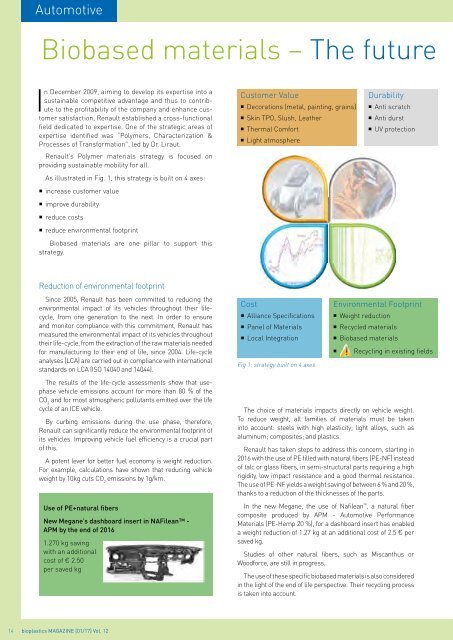Issue 01/2017
bioplasticsMAGAZINE_1701
bioplasticsMAGAZINE_1701
You also want an ePaper? Increase the reach of your titles
YUMPU automatically turns print PDFs into web optimized ePapers that Google loves.
Automotive Materials<br />
Biobased materials – The future<br />
In December 2009, aiming to develop its expertise into a<br />
sustainable competitive advantage and thus to contribute<br />
to the profitability of the company and enhance customer<br />
satisfaction, Renault established a cross-functional<br />
field dedicated to expertise. One of the strategic areas of<br />
expertise identified was “Polymers, Characterization &<br />
Processes of Transformation”, led by Dr. Liraut.<br />
Renault’s Polymer materials strategy is focused on<br />
providing sustainable mobility for all.<br />
As illustrated in Fig. 1, this strategy is built on 4 axes:<br />
• increase customer value<br />
• improve durability<br />
• reduce costs<br />
• reduce environmental footprint<br />
Biobased materials are one pillar to support this<br />
strategy.<br />
Customer Value<br />
• Decorations (metal, painting, grains)<br />
• Skin TPO, Slush, Leather<br />
• Thermal Comfort<br />
• Light atmosphere<br />
Durability<br />
• Anti scratch<br />
• Anti durst<br />
• UV protection<br />
Reduction of environmental footprint<br />
Since 2005, Renault has been committed to reducing the<br />
environmental impact of its vehicles throughout their lifecycle,<br />
from one generation to the next. In order to ensure<br />
and monitor compliance with this commitment, Renault has<br />
measured the environmental impact of its vehicles throughout<br />
their life-cycle, from the extraction of the raw materials needed<br />
for manufacturing to their end of life, since 2004. Life-cycle<br />
analyses (LCA) are carried out in compliance with international<br />
standards on LCA (ISO 14040 and 14044).<br />
Cost<br />
• Alliance Specifications<br />
• Panel of Materials<br />
• Local Integration<br />
Fig 1: strategy built on 4 axes<br />
Environmental Footprint<br />
• Weight reduction<br />
• Recycled materials<br />
• Biobased materials<br />
• Recycling in existing fields<br />
The results of the life-cycle assessments show that usephase<br />
vehicle emissions account for more than 80 % of the<br />
CO 2<br />
and for most atmospheric pollutants emitted over the life<br />
cycle of an ICE vehicle.<br />
By curbing emissions during the use phase, therefore,<br />
Renault can significantly reduce the environmental footprint of<br />
its vehicles. Improving vehicle fuel efficiency is a crucial part<br />
of this.<br />
A potent lever for better fuel economy is weight reduction.<br />
For example, calculations have shown that reducing vehicle<br />
weight by 10kg cuts CO 2<br />
emissions by 1g/km.<br />
Use of PE+natural fibers<br />
New Megane’s dashboard insert in NAFilean -<br />
APM by the end of 2<strong>01</strong>6<br />
1.270 kg saving<br />
with an additional<br />
cost of € 2.50<br />
per saved kg<br />
The choice of materials impacts directly on vehicle weight.<br />
To reduce weight, all families of materials must be taken<br />
into account: steels with high elasticity; light alloys, such as<br />
aluminum; composites; and plastics.<br />
Renault has taken steps to address this concern, starting in<br />
2<strong>01</strong>6 with the use of PE filled with natural fibers (PE-NF) instead<br />
of talc or glass fibers, in semi-structural parts requiring a high<br />
rigidity, low impact resistance and a good thermal resistance.<br />
The use of PE-NF yields a weight saving of between 6 % and 20 %,<br />
thanks to a reduction of the thicknesses of the parts.<br />
In the new Megane, the use of Nafilean , a natural fiber<br />
composite produced by APM - Automotive Performance<br />
Materials (PE-Hemp 20 %), for a dashboard insert has enabled<br />
a weight reduction of 1.27 kg at an additional cost of 2.5 € per<br />
saved kg.<br />
Studies of other natural fibers, such as Miscanthus or<br />
Woodforce, are still in progress.<br />
The use of these specific biobased materials is also considered<br />
in the light of the end of life perspective. Their recycling process<br />
is taken into account.<br />
14 bioplastics MAGAZINE [<strong>01</strong>/17] Vol. 12


















